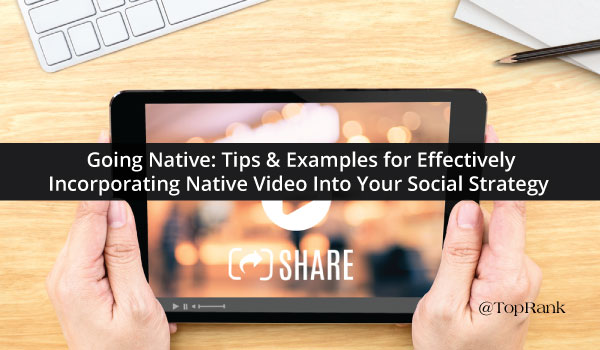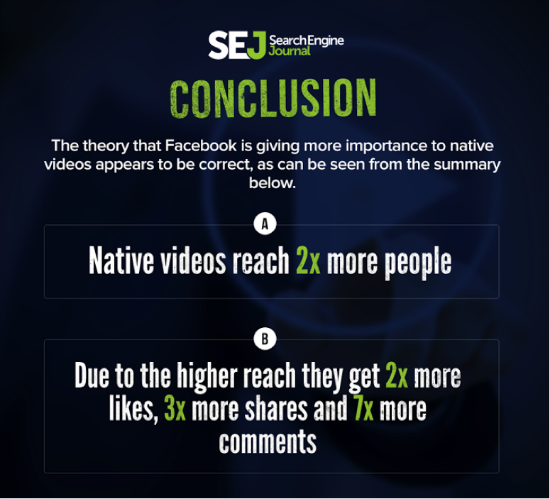These days, it’s pretty safe to say that all marketers understand that video is an increasingly important marketing tool for capturing audience attention, showing value and encouraging engagement across the digital universe. In fact, 87% of online marketers use video content, according to an infographic from Hyperfine Media.
However, when it comes to promoting that video content on social media, marketers often ask users to click a link to a website, blog or another outside platform to watch, rather than just giving them the content outright. But as social media platforms improve their video shooting, editing and uploading capabilities, many brands and marketers are going native with their video content.
What is Native Video?
When looking at it in the context of social media, native video is any video content that is created in or directly uploaded to a social media platform, which then auto-plays with the news feed. Native video is perhaps most recognizable on Facebook, Twitter and Instagram.
Why should your brand consider native video? How do you get started? Below I aim to answer those questions and more, as well as provide you with some insights for incorporating native video and examples of native video in action.
Why Brands Should Consider Native Video
#1 – Native video boosts engagement.
Successful social media marketing requires creating a connection with your audience by providing them with content that educates, entertains, and encourages interaction and engagement. Since native video content lives on your social media page, you’re eliminating a barrier to that interaction and keeping people engaged with your brand in that very moment—rather than sending them to another space.
In addition, if your native video content hits the right spot, it will inspire shares and expand your reach beyond your current following.
#2 – Native video has a leg up on third-party embeds.
At least when it comes to native video on Facebook, the social media platform’s algorithm seems to favor native over embedded video content. Last year, Search Engine Journal took a look at native video content versus YouTube content on Facebook and found that native content reaches two times more people—and, as mentioned above, native video content receives way more engagement.
(Image Credit: Search Engine Journal)
#3 – Native video can help further the brand-customer relationship.
When you give your audience compelling native video content—with no strings attached and no extra clicks needed for them to enjoy—you’re showing users that you’re not just looking for a sale, but to give them something of value. This approach can help build brand awareness and trust that is the foundation for the brand-customer relationship.
Examples of Native Video on Action
#1 – TopRank Marketing & DivvyHQ
Earlier this year, TopRank Marketing partnered with DivvyHQ to create the Easy-as-Pie Guide to Content Planning eBook, which featured three recipes for improving content planning and effectiveness. As part of the project, we created a motion graphic video to tease all the great stuff in the eBook. The video was uploaded to YouTube and web content, but was uploaded it natively to Facebook.
For TopRank Marketing’s Facebook channel, we saw a almost 2000% more views for the native video than the one that was uploaded to YouTube.
#2 – Tasty
Tasty videos have become a staple in many Facebook feeds and cause many users to stop, watch, drool and save the recipes to make later.
What makes these videos so compelling is the fact that they do their job without relying on sound. When a video auto-plays in a news feed, they’re usually muted until you click on the video. Below is one of Tasty’s latest Facebook posts. Check out the engagement data on it!
#3 – FamilySearch
FamilySearch is the world’s largest genealogy organization, providing family history lovers with the ability to preserve and discover their family’s past. They boast huge followings on their social networks not only because they provide a quality service, but they also work to engage their audience—and native video is a part of their strategy.
Here’s an example of a recent Twitter post promoting their efforts to get 72,000 people to index and save world history records in just 72 hours.
Have you re-written history? Join now!#theworldsrecords https://t.co/ZzVqc6UcRB pic.twitter.com/r33HelykIz
— FamilySearch (@FamilySearch) July 17, 2016
In addition, a motion graphic video posted natively to their Facebook page has nearly 11,000 views, 476 likes and 165 shares after being posted about a month ago.
;
#4 – Great Big Story
Great Big Story is a CNN-funded startup that produces original videos on off-beat topics that aim to engage young audiences. A recent blog post by NewsWhip dove into the company’s native video strategy, featuring insights from Great Big Story’s Director of Audience Intelligence Khalil Jetha.
One key part of their strategy is customizing the experience for each of its channels—Facebook, Vimeo, YouTube and their own website. Below is one of their most recent native Facebook posts. When I found it, it was just two hours old and already had nearly 460,000 views.
Tips for Incorporating Native Video into Your Social Strategy
#1 – Use your text wisely.
While native videos will auto-play in the news feed, you’ll need to add a little flavor and context to what you’re showing people in the post itself. Be creative and compelling, and try to keep it short and sweet.
#2 – Customize content for your audience.
In NewsWhip’s article, Jetha stresses the need to understand your audience and the platform you’re using.
Figuring out out who your audience is, and why they’re interacting with you on that platform is more important than creating one unified brand strategy across every single social network,” he said. “When I say that, I mean that you can’t expect to repurpose one piece of content the exact same way and put it up on different networks.
#3 – Create something that speaks for itself.
As I mentioned in my comments about Tasty’s native video posts, in most cases sound doesn’t happen unless the video is clicked on. Work to create something that doesn’t need sound to give it meaning and understanding.
#4 – Experiment with live video options.
Twitter’s Periscope and Facebook Live, as well as Instagram, provide brands with the opportunity to give their audiences native video content that’s a little more raw and authentic. This kind of video content can be great for giving your followers a sneak peek of a new product or special event you’re attending.
#5 – Make native video a part of of your overall social media (digital marketing) strategy.
Tossing up a native video every now and then won’t give you the results you’re looking for. Use your audience personas and data you’ve collected for each social media platform and decide where native video would make sense. Then work it into your overall strategy like you would any other piece of content.
#6 – Don’t force it.
It’s true that users are hungry for video content, but that doesn’t mean you need to burn your current strategy to the ground and rebuild it with native video. Whether or not native video is right for your brand is ultimately going to depend on who your audience is and what resonates with them, as well as what your overall marketing and business objectives are.
Are you using native video as a social media marketing tactic? What have your results been? Tell us in the comments section below.
Disclosure: FamilySearch was a TopRank Marketing client at the time this campaign was launched.
Gain a competitive advantage by subscribing to the
TopRank® Online Marketing Newsletter.
© Online Marketing Blog - TopRank®, 2016. | Going Native: Tips & Examples for Effectively Incorporating Native Video Into Your Social Strategy | http://www.toprankblog.com
The post Going Native: Tips & Examples for Effectively Incorporating Native Video Into Your Social Strategy appeared first on Online Marketing Blog - TopRank®.


No comments:
Post a Comment